|
Movement finder Articles Time journey Museum |
| © Copyright Antonios Vassiliadis |
 |
|
|
|
 |
|
| Spring 1900. Easter time. Two greek fisher boats - called kaiki, with six sponge divers and twenty rower onboard, were sailing from their home harbour Symi to a diving expedition around northern Africa, destination tunesian fishing grounds. Hungry for sponges, they navigated between the greek main land (Peloponnes) and Crete passing cape Malea. This ship route was famous for sudden "Meltemi" winds, infamous for rising swiftly and suddenly. It happened as it has to be, they run into wild weather and the greek captain Dimitrios El. Kontos was afraid about safety for his crew and ship. Realizing no other choice than to shelter from storm he decided to anchor in a bay, between northern Kythira and Crete southeast, at the island of Antikythera. After three days, easter tuesday, the storm passed by and the captain ordered his divers to look around in the protecting bay "pinakakia" for more sponges, eastern from the harbor of Potamos. Around twenty metres off the rocky coast they ancored. During the first dive, suddenly Ilias Lykopantis or Stadiatis (originated from Stadia in Asia Minor) discovered at depths of 42-50 metres statues and came back to surface! Taking off his copper helmet, he must have explained the happening like a waterfal to his captain, but captain Kontos wanted to be sure and slipped into the diving suit for an own dive to the sea ground. Exploring the ground between stones with sea gras and sand, he found something... Back to surface, he was shaking his hand with a bronze arm of a statue. The place was off Point Glyphadia, around 25 meters from the shore of the small island. | |
 |
|
| Image from GOOGLE maps | |
  |
|
| Image left is showing captain Kontos his ship, image to the right Dimitrios El. Kontos with his family (image around 1900) | |
| Many sources told easter tuesday for the date of finding the shipwreck. The archaeological museum of athens reported officially around eastern. In the spring time the sponge divers started to travel to their fishing grounds, working approx. half a year and came back mostly successfully - if no diver died. Other sources like the british author Jo Marchant "Decoding the Heavens", published in 2008, told the autumn for the date of founding the shipwreck, on their way back to their home destinations in greece. Contacting Jo Marchant, she explained about two different sources with two different timings, after she started to write her book in 2006. But none of these sources could be proofed with documents. So, the author decided the autumn. Some years later, in 2012, the greek ministry of culture and sports published another book "The Antikythera Shipwreck: the ship, the treasures, the mechanism", written by Nikolaos Kaltsas, Elena Vlachogianni and Polyxeni Bouyia in which spring was called to be the correct date. Their source was the greek archive of archaeological service (HAAS). | |
| After the find of the artefacts, the reports went into two different directions... Officially, according to greek sources, captain Kontos measured that shipwreck and sailed back to the island of Symi. Arrived, he was first celebrated as hero, but after meetings with the oldest on the island he sailed back to Athens to alert the discovery to authorities of the greek government. So far everything sounded fine. But what, if this wasn´t the whole story? Even in that time it wasn´t easy for jobs like sponge divers with their dangerous proffession, were only the young as fittest and strongest kept survived. High risking without a decompression measurement gave them an early dead or injured severely till end of their life time. | |
| That the story automatically changed, from story teller to story teller with different fantasy, was clear. In that point, the americain archaeologist, reporter and diver Mr.Peter Throckmorton doubted this happening and wanted to look behind this story. He went back to roots of the history beginnings, searched and found time whitnesses, which remembered from that time period. On the island of Symi, in taverns they said that the captain was trying to retrieve as much as possible, either to deposit somewhere or to sell the artefacts as quick as possible. Rumors said also that especially in Egypt, in Alexandria, between 1902 and 1910 many little bronze statues were sold. It was also strange that the bly weights from the anchor of the shipwreck was never found. Divers in that time used bly weights with their shoes or belts, but bly was expensive. As a question of keeping survive in poor times this might be a motive from a clever trader like a captain´s need for good business. So, just after all was retrieved and nothing was in the reach of divers possibility, they came to the idea to alert the government, asking a reward for the found ancient shipwreck. | |
| The hidden sensation | |
| In November that year, sponge boat captain Dimitrios Kontos with his diver Stadiatis went to Athens with a bronze arm. They appointed the symiotian Professor for archaeology A.Ikonomu, at the university of Athens. November 6th, the three men met the minister for Education Mr. Spiridon Stais and reported the discovery to other authorities of the greek ministry of culture, their discovery of an ancient shipwreck within greek territory. Immediately the Hellenic Navy dispatched the vessel "Mykali" to the island to support recovery operations. November 24th, the "Mykali" arrived at the island of Antikythera, but after a while they realized its uncomfortable big dimension to manouvre safely in the small harbor of Potamakia with its rocks and exchanged the "Mykali" by the civilian steam ship "Syros". At december 4th the recovery continued. Later the Navy torpedo boat "Aigialeia" followed. During the next several months, the divers braved winter storms and dives beyond 50 m. They shared a single diving suit and helmet, taking turns of ten minutes twice per day. Despite the divers’ great skill and personal bravery, two men were severely injured and another diver, Georgios Kritikos or Tourkokritikos (Cretan of Turkish descent) lost his life. By the end of the operation in September 1901, only five men were still fit to dive. They retrieved statues, jewellery, fine furniture, pottery, unique glassware (from Syria-Palaestina and possibly Egypt), wine and bronzes. But the most important finds proved to be a few green, corroded lumps - the last remnants of an elaborate mechanical device. On 17 May 1902, archaeologist Valerios Stais was examining the finds and noticed that one of the pieces of rock had a gear wheel embedded in it. | |
 |
|
| The names of the sponge divers (established by Eleni Kladaki-Vratsanou): Ilias Lykopantis or Stadiatis (originated from Stadia in Asia Minor), Kyriakos Mountiadis, Georgios Mountiadis, Ioannis Piliou or Roditis (originated from Rhodes), Georgios Kritikos or Tourkokritikos (Cretan of Turkish descent, lost his life during the operations), Vasilios Katsaras, Konstantinos Kalafatis and Vasilios Zouroudis (Image: Courtesy of the greek archive of monuments) | |
 |
|
| Winter 1900/1901: Representatives of the Hellenic government, the crew, and the sponge divers on the deck of the Hellenic Navy vessel "Mykali" (image: Courtesy of the greek archive of monuments) | |
| In the beginning of the 90s, with the technical progress of X-ray and radiocarbon technology (radiocarbon dating) it was able to estimate the date of the artefact mechanism 150 - 100 BC and the wood pieces for a ship built issued 220 BC. These wooden pegs and tenons used in the Antikythera ship were made of oak (Lat. quercus), whereas the planks were made of elm (Lat. ulmus). The retrieved coins from Pergamon issued 86 and 67 BC, those of Ephesus issued 70 - 60 BC. Other coins from Sicily and Asia minor issued older. The conclusion was, that this ship sunk 70 - 60 BC (time period of the Second and Third Mithridatic War). The source of this mechanism was probably made by a gifted mechanic of the school of Posidonius of Rhodes. Marcus Tullius Cicero visited 79/78 BC the island and reported about a similar device, which came from the greek philosopher Posidonius of Apamea. His mechanism and that from Antikythera followed the manuscript of Archimedes about the planetarium. Such sophisticated technology was not thought to be developed by humanity for another 1.000 years. | |
| Jacques Cousteau | |
| In 1953 Captain Jacques-Yves Cousteau sailed from France to the Aegean in the famous ship "Calypso". On board with him was MIT engineering professor Harold “Doc” Edgerton. Doc had a new underwater strobe to test, financed by the National Geographic Society. On 15th of August, "Calypso" weighed anchored off Kythira and sailed to the island of Antikythera. On the morning of 16th of August, Frederic Dumas and Cousteau dived on the wreck site. They noted the main artifact concentration at 55 m, and followed the debris trail to a depth of nearly 70 m. They and other "Calypso" divers ranged a quarter mile north and south from the wreck to see what else they could find. At a point about 500 feet south, they located another ancient shipwreck. It was marked by amphoras sticking out of the sand at 42 m depth, with a lead anchor stock nearby. | |
 |
|
| Jacques Cousteau with his "Calypso" | |
| During the night of 16th August, they tested the experimental underwater strobe and camera in the island’s harbor, Potamos. The flashes were visible from shore, and a concerned local alerted the island’s lone policeman. The policeman came aboard "Calypso" to protest, stating that he would inform the authorities in Athens. Cousteau had obtained permission from the Greek government for all of their activities, but nevertheless, the police ordered the ship to leave the island immediately. But a week later they returned back to Antikythera for just one diving day. After the ship left again for Delphi, irony of destiny said that this wasn´t the last time... | |
    |
|
  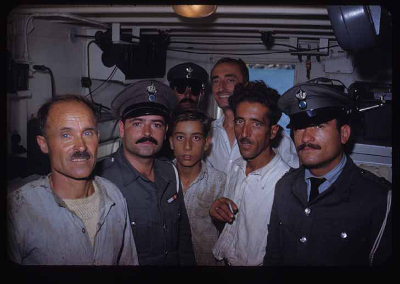 |
|
| Images Harold Eugene Edgerton, 1953 | |
| The second dive expedition of Jacques Cousteau | |
| His status of his famous underwater expeditions during the past years made Jacques Cousteau and his team a nice surprise, when the greek government invited him in 1976 for diving at several areas in greece - after over 20 years. Again coming back to see greece... The background was to merchandise the beauty of greece and to push the tourism. | |
   |
|
   |
|
| Images Harold Eugene Edgerton, 1976 | |
  |
|
| Underwater image to the left Vasilis Mendiogiannis, right Peter Nicolaides | |
  |
|
| Underwater images Lefteris Tsavliris | |
|
This time they
took every square metre pictures and a report in a documentation map.
Afterwards each section was observed. During this project, the diving team
of Jacques Cousteau was supported by greek divers of the Greek Institute
of Marine Archeology: Vasilis
Vitalis, John Garas and Petros Nikolaidis. Working with the dregde
sucked away sediments to expose artifacts
(an underwater hoover), sucking the sediments away to expose artifacts,
allowed for each diver two 10-minute divings each day. But after some
breaks of hampded weather, all so far known findings were excavated from
the seafloor during 27 diving days untill november 1976. Today the
mechanism with other findings is exhibited in the section of bronze in the
National museum of Greek Archeology in Athens. |
|
| Shipwrecked around 65 BC | |
 |
|
| At the beginnings of the 1990s the planks (elm timber - Lat. ulmus, known in the Aegean region as karagatsi and oak - Lat. quercus) of the shipwreck were identified with the C14-dating method and resulted the built of the ship 260-180 BC - around 220 BC +43. These identified wood fragments came from Italy. Greek ships were built in that time period with pine wood from Samos or Aleppo. The found coins on board of the shipwreck came from Pergamon - 86-67 BC and from Ephesos, 70-60 BC. As a result, the ship sunk around 70-60 BC (time of the 2nd and 3rd Mithridate war). Scientists estimated that the source of this mechanism was from the talented mechanic Geminus of Rhodos from the school of Poseidonios from Apameia (Syria) at Rhodos. Poseidonios was a rhodonian with greek-syrian roots and supporter of the rule of the nature from the stoics. The assumption about Poseidonios was to be doubt in july 2007, just after the latest results of 12 korinthian months on the mechanism. Now the scientists assume its inventor not anymore from Rhodos but also from Korinth... | |
| 2012 | |
  |
October 2012, marine archeologist Dr. Brendan P. Foley of the Woods Hole Oceanographic Institution, United States received a diving permission. A little group with newest scuba diving technology wanted to survey the seafloor around the shipwreck for a futured diving expedition. During 3 weeks they realized the doubled dimension of the sunken ship and in depths around 70 meters new fragments were also found. |
| Dr. Brendan Foley - Copyright Giogos Koutsouflakis (Ephorate of Underwater Antiquities) | |
  |
|
| The diving team of 2012 | |
| 2013 - "Projekt Contour" | |
|
Experts came to the conclusion that the area of that ship route would show more ancient shipwrecks.
During the time Sept. 15 – Oct. 15 2013, the
Hellenic Ephorate of Underwater Antiquities
ordered the team Dr.Theotokis Theodoulou
and Dr.Brendan P.Foley for another survey. Equippment with 3D sonar
EdgeTech 4600 they located between Western
Crete and
Antikythera six
ancient shipwrecks and five anchorages, thus gaining new insights into the
history of the Antikythera shipwreck. These six ancient shipwrecks were
located in the area of the two western peninsulae of Crete: three of Roman
times (one with a cargo of stone blocks weighing more than 100 tons, the
second with a cargo of amphorae and utilitarian pottery and the third with
a cargo of African amphorae), two with amphorae of the Middle Byzantine
period and one with a cargo of unidentified perforated stones. Also, the
relics of a modern metal shipwreck and the remains of a 19th-century
shipwreck were located, which could be attributed to the "HMS
Cambrian" that sank while bombarding pirates in the castle
of Gramvousa in January 1828. |
 |
  |
|
  |
|
 |
The Hellenic Ephorate of Underwater Antiquities, led by the maritime archaelogist Dr.Theotokis Theodoulou, with the technical and financial support of the Woods Hole Oceanographic Institution (WHOI) represented by Dr. Brendan P. Foley, and Philipp Short with 14 additional divers, surveyed successfully the seafloor between Western Crete and the island of Antikythera. Equipped with metal detectors, special lamps and video shots during examinations, here the ship’s lead anchor stock, about 1.4 metres long and weighing close to 200 kg. It is now being restored by the Ephorate, before being added to the Antikythera Shipwreck exhibition. See the 3 different scuba bootles for each diver. Image to the left, Philip Short and Alexandros Sotiriou convoyed together a retrieved piece. Carefully coming up with a greek amphore to the surface. Underwater photographer: Alexandros Sotiriou / Hellenic Ephorate of Underwater Antiquities / WHOI |
| 2014 - Dive expedition "Return to Antikythera" | |
| The treasures that were recovered at Antikythera were so important, that from Sept 15 - Oct 7 another important diving expedition took place. Here a new diving suit technology was shown: the USD 1.5 million EXOSUIT of the canadian specialist Nuytco Research in Vancouver, supported by the US-americain J.F.White Contracting Co. in Massachussets and the Swiss watch company HUBLOT. | |
  |
|
| The EXOSUIT for the diving expedition in 2014 (Copyright Nuytco Research & newscientist) | |
| When Greek sponge fishermen found the shipwreck in October 1900, the pressure was such that they had only 5-10 minutes on the seabed before having to ascend. By the time underwater explorer Jacques Cousteau led an expedition to the ship in 1976, the amount of time that could be spent at the bottom had been extended to just 10 minutes (2 times a day = 20 minutes) each dive. To maximise their efficiency, Cousteau's divers used a vacuum system to suck up a small area of the wreck, but this risked damaging or destroying priceless fragile objects. In 2012 with the improvement of "rebreathers" (special recycled scuba air) they could stay for 30 minutes. The new expedition won't face such time constraints. "With the Exosuit, our bottom time becomes virtually unlimited," says Brendan Foley, co-director of field operations at WHOI's Deep Submergence Laboratory. "Now we can have an archaeologist in the suit for hours, and we'll only have to come up to answer the call of nature." | |
 |
|
| Scientists from Woods Hole Oceanographic Institution in Massachusetts and the National Museum of China in Beijing are already using "rebreathers" (image courtesy of Popular Science) | |
| Now a team of international archaeologists including Dr. Brendan Foley of the Woods Hole Oceanographic Institution and Dr. Theotokis Theodoulou of the Hellenic Ephorate of Underwater Antiquities have returned to the treacherous site using state-of-the-art technology. During their first excavation season, from September 15 to October 7, 2014, the researchers have created a high-resolution, 3D map of the site using stereo cameras mounted on an autonomous underwater vehicle (AUV). Divers then recovered a series of finds which prove that much of the ship’s cargo is indeed still preserved beneath the sediment. Components of the ship, including multiple lead anchors over a metre long and a bronze rigging ring with fragments of wood still attached, prove that much of the ship survives. The finds are also scattered over a much larger area than the sponge divers realized, covering 300 meters of the seafloor. This together with the huge size of the anchors and recovered hull planks proves that the Antikythera ship was much larger than previously thought, perhaps up to 50 meters long. “The evidence shows this is the largest ancient shipwreck ever discovered,” says Foley. “It’s the Titanic of the ancient world.” The archaeologists also recovered a beautiful intact table jug, part of an ornate bed leg, and most impressive of all, a 2-meter-long bronze spear buried just beneath the surface of the sand. Too large and heavy to have been used as a weapon, it must have belonged to a giant statue, perhaps a warrior or the goddess Athena, says Foley. In 1901, four giant marble horses were discovered on the wreck by the sponge divers, so these could have formed part of a complex of statues involving a warrior in a chariot that was pulled by the four horses. The wreck is too deep to dive safely using regular scuba equipment, so the divers had to use rebreather technology, in which carbon dioxide is scrubbed from the exhaled air while oxygen is introduced and recirculated. This allowed them to dive on the site for up to three hours at a time. | |
  |
|
| Members of the Hellenic Navy Seal (O.Y.K) team providing in-water support for the Exosuit. Image right: One of the most exciting finds was a 210 cm section of a bronze spear (Images: ARGO, Brett Seymour) | |
|
The archaeologists plan to return next year to excavate the site further
and recover more of the ship’s precious cargo. The finds, particularly the
bronze spear, are “very promising,” says Theodolou. “We have a lot of work
to do at this site to uncover its secrets.” The Woods Hole Oceanographic Institution is a private, non-profit organization on Cape Cod, Mass., dedicated to marine research, engineering, and higher education. Established in 1930 on a recommendation from the National Academy of Sciences, its primary mission is to understand the ocean and its interaction with the Earth as a whole, and to communicate a basic understanding of the ocean’s role in the changing global environment. For more information, please visit www.whoi.edu. |
|
| 2015 "Return to Antikythera" (26.08. - 16.09.2015) | |
 |
|
|
Tuesday: on our way to Antikythera. Flat calm transit, rounded Maleas,
put in to Kapsali for rendezvous and vehicle testing/calibration. -
See more at:
http://antikythera.whoi.edu/2015/06/10/#sthash.X2888Rjj.dpuf
Tuesday: on our way to Antikythera. Flat calm transit, rounded Maleas,
put in to Kapsali for rendezvous and vehicle testing/calibration. -
See more at:
http://antikythera.whoi.edu/2015/06/10/#sthash.X2888Rjj.dpuf
Tests in June at Antikythera. To the right
the "Glaros" |
|
|
Tuesday: on our way to Antikythera. Flat calm transit, rounded Maleas,
put in to Kapsali for rendezvous and vehicle testing/calibration. -
See more at:
http://antikythera.whoi.edu/2015/06/10/#sthash.X2888Rjj.dpuf
|
|
|
During an expedition mounted in 2014 the researchers created a high-resolution, 3D map of the site using stereo cameras mounted on an autonomous underwater vehicle (AUV). Hampered by bad weather, the expedition included just four dive days for professional technical divers who recovered a series of finds on the surface sediment and proved that much of the ship’s cargo is indeed still preserved beneath the sediment. By contrast, this year’s expedition included 40 hours of bottom time, with four professional archaeologists diving the site and performing controlled excavation to the highest scientific standard with specially designed equipment, and with the guidance of an exquisitely precise multi-dimensional map of 10,500 square meters of sea floor. |
|
  |
|
 |
The international team was in the field from 26 August to 16 September, following an autonomous robotic mapping effort conducted from 8-15 June in partnership with the University of Sydney, Australia. The project is the first-ever systematic excavation of this shipwreck, relying on the precise large-area map created by the robotic survey. Notably, this project marked the first time in the century since the wreck’s discovery that archaeologists were able to join specialist divers in descending to the 55-meter (180 feet) deep site. The ten-man dive team used advanced technical diving equipment including closed-circuit rebreathers and trimix breathing gases, performing 61 dives in 10 days of diving on the wreck. A remotely operated vehicle (ROV) monitored and recorded all diving activities, and served as a communications link between divers and support personnel on the surface. The 2015 expedition has left the team with the best understanding yet of this unique shipwreck and its cargo. A metal detection survey of the site revealed that metallic targets are dispersed over an area of about 40x50 meters. This is thought to match the wreck’s debris field, indicating the vast size of the ship that sank off the forbidding cliffs of Antikythera. |
 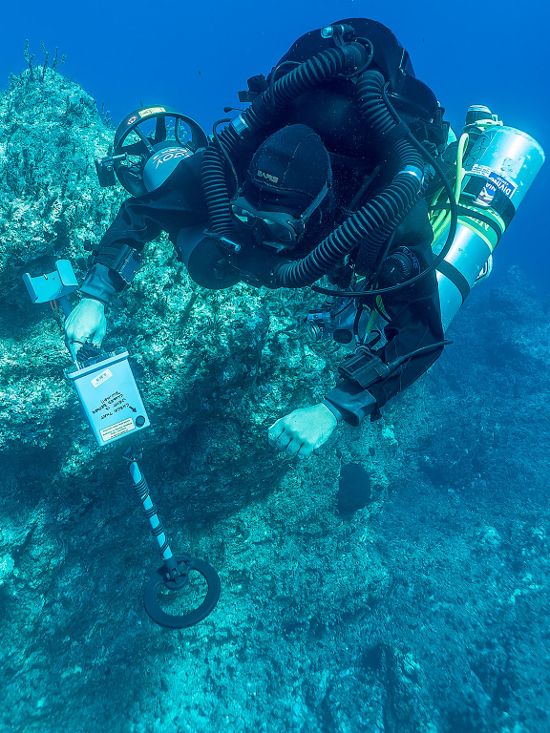 |
|
| Metal detectors revealed the presence of buried objects throughout the wreck site. The dive team recovered items including an intact amphora; a large lead salvage ring; two lead anchor stocks (possibly indicating the ship’s bow); fragments of lead hull sheathing; a small and finely formed lagynos (or table jug); and a chiseled rectangular stone object (possibly the base of a statuette) perforated by 12 holes and filled with an as-yet-unidentified substance. | |
  |
|
| During the project, the dive team carefully excavated a series of nine trenches in the seabed using a water dredge powered by a submersible pump. | |
  |
|
| The divers recovered more than 50 artifacts, most deeply buried beneath a thick layer of coarse sand and massive deposits of broken ceramics. From among these fragments, the team recovered wooden remains from the hull of the ship; a section of bronze furniture, perhaps from a throne; part of a bone flute; a glass “chessman” board game element; bronze nails from the ship’s planks; and portions of bronze, iron, glass and ceramic objects. | |
 |
|
|
“We were very lucky this year, as we excavated many finds within their context, which gave us the opportunity to take full advantage of all the archaeological information they could provide,” states diving archaeologist Dr. Theodoulou. The team created 3D virtual reconstructions of many artifacts on the seafloor, and 3D-modeled all of the major recovered artifacts once on shore. A series of scientific analyses are now being conducted on these artifacts, including ancient DNA analysis of ceramic jars to identify the 2,000 year-old food, drinks, perfumes, and medicines contained in them. Isotopic analysis of lead objects will determine where the lead was mined, to reveal the home port of the ship. The 2015 project team includes Greek and foreign archaeologists, technical divers, engineers, photographers, filmmakers, technicians, etc. (Y. Bitsakis, D. Conlin, J. Fardoulis, N. Giannoulakis, C. Kaiser, Μ. Kelaides, E. Kovacs, C. Lees, D. Manoliadis, Ε. O’Brien, O. Pizarro, D. Romios, B. Seymour, P. Short, G. Smith, Α. Sotiriou, A. Tourtas, Μ. Tsimperopoulos, S. Williams). The robotic mapping surveys were conducted by the Australian Centre for Field Robotics of the University of Sydney. The research team expressed gratitude to supporters of their project including the Swiss premier horology company Hublot S.A., the Swordspoint Foundation (USA), the Aikaterini Laskaridis Foundation, Jane and James Orr, private sponsors of the Woods Hole Oceanographic Institution, Costa Navarino, the Municipality of Kythera and the community and residents of Antikythera, and OTE-Cosmote, which provided telecommunications in the field. |
|
| 2016 "Return to Antikythera" (22nd May - mid June 2016) | |
 |
|
| Arrival of Dr.Brendan Foley and Dr.Theodoulou on the island. Season starting! | |
 |
|
| "Kalimera" Andikythira! | |
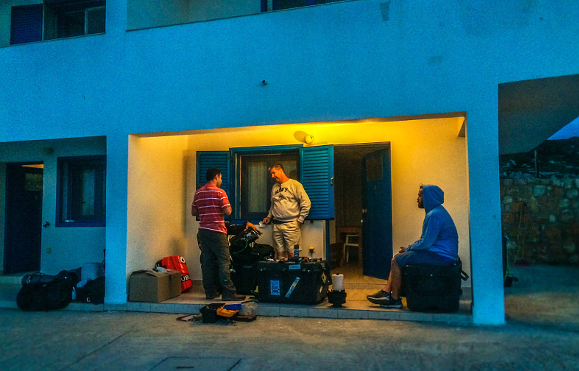  |
|
  |
|
  |
|
| Preparations for the divings. | |
| First week at Antikythera | |
|
Recap of our first week at Antikythera: on Wednesday, the team was
completed with the last arrivals; diving operations manager Phil Short
and chief diver Gemma Smith flew in via helicopter, and were warmly
greeted. Thanks to our friends at Costa Navarino Resort for delivering
essential personnel in such style! - See more at:
http://antikythera.whoi.edu/2016/05/29/#sthash.61f7XiBj.dpuf
Recap of our first week at Antikythera: on
wednesday, the team was completed with the last arrivals; diving
operations manager Phil Short and chief diver Gemma Smith flew in via
helicopter, and were warmly greeted. Thanks to our friends at Costa
Navarino Resort for delivering essential personnel in such style! On
thursday, we conducted the first dive of the season on the Antikythera
shipwreck site. We recovered artifacts we left positioned from last
season, set the mooring lines and conducted a general site inspection,
which showed no evedent interference. The good weather condition from
friday and during the weekend allowed more dives and targeted metal
detection with a brand new device, specially designed for the site. |
|
  |
|
| Dr.Brendan Foley is about to dive. Alexandros Sotiriou is assisting with final checks | |
 |
|
| Gemma Smith on her way to the 55m drop to the wreck site (© Brett Seymour) | |
  |
|
| Dr.Brendan Foley on the wreck site with amphoras and a wonderful find: a golden ring! (© Brett Seymour) | |
| 2016 "Return to Antikythera" - August | |
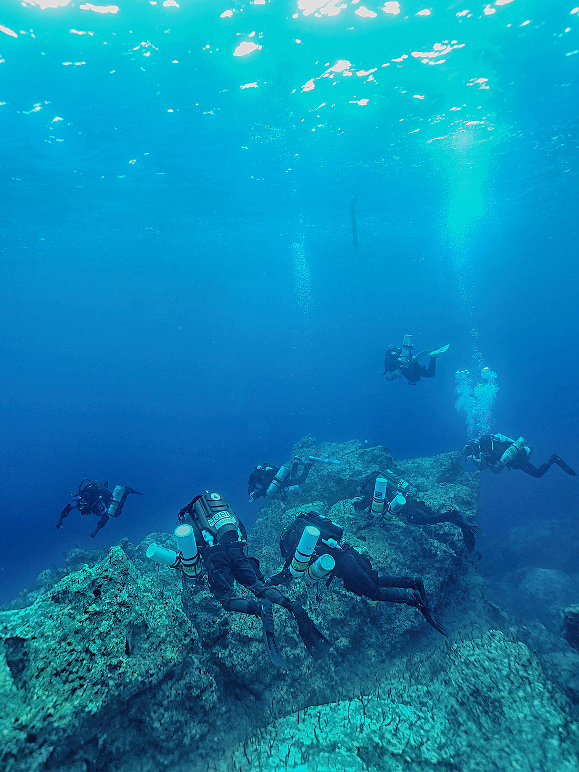  |
|
| The “Return to Antikythera” international research team discovered a human skeleton during its ongoing excavation of the famous Antikythera Shipwreck. The first skeleton recovered from the wreck site during the era of DNA analysis, this find could provide insight into the lives of people who lived 2100 years ago. The team excavated and recovered a human skull including a jaw and teeth, long bones of the arms and legs, ribs, and other remains. Other portions of the skeleton are still embedded in the seafloor, awaiting excavation during the next phase of operations. | |
| © Macmillan Publishers Ltd. 2016 | |
| “Archaeologists study the human past through the objects our ancestors created,” said Brendan Foley, a marine archaeologist with WHOI. “With the Antikythera Shipwreck, we can now connect directly with this person who sailed and died aboard the Antikythera ship.” The skeleton discovered on August 31, 2016, is the first to be recovered from an ancient shipwreck since the advent of DNA studies. Ancient DNA expert Dr. Hannes Schroeder of the Natural History Museum of Denmark in Copenhagen, hastened to Antikythera to view the remains. Once permission is obtained from the Greek authorities, samples will be sent to his laboratory for a full suite of analyses. If enough viable DNA is preserved in the bones, it may be possible to identify the ethnicity and geographic origin of the shipwreck victim. “Against all odds, the bones survived over 2,000 years at the bottom of the sea and they appear to be in fairly good condition, which is incredible,” said Schroeder. | |
| 2017 "Return to Antikythera" (Sept. 4th - Oct. 04th 2017) | |
 |
The Ephorate of Underwater Antiquities completed the new underwater
excavation/mission at the Antikythera Shipwreck. The research lasted from
4th to 20th of September under excellent weather conditions for first time
after 2014 when was completed the detailed mapping of the area where a
Roman era ship was wrecked. The ship was loaded with a cargo of art pieces
and luxury goods, among of which the famous Antikythera Mechanism was also
recovered. The excavation was continued at the trench from where human remains were recovered last year, plus equipment of the ship itself like lead pipes, counterweights, iron encrustations of possible ship tools, etc. The trench continued to deliver similar material among ample pottery shards of amphorae and other vessels. Meanwhile the excavation was extended to two more areas where marble and bronze statue fragments where located under big stone boulders that slip to the area because of a severe seismic event. Notable among the fragments is a bronze arm, that increases the number of bronze statues that are considered to lie down at the site, taken in consideration the sparse elements recovered before. Another important bronze statue element is that of a clothing/dressing. Distinguished among the marble fragments is also that of a nude possible male leg embedded on a base (plinth) that was located under a huge boulder. Further smallest finds, pottery shards, nails, lead sheathing fragments as well as objects that witness the passing from the site of the Cousteau – MOCS team in 1976, were plotted or recovered. Several unidentified -though initial visual observation- finds are also supposed to be studied further for their interpretation. Most considerable one seems to be a metal disc with four holed protrusions, decorated with a bull that was observed with the use of x-rays. Exclusively significant are also fragments of the ship-shell (skeleton and planking) that was located. These, in consideration with the rest of the finds, the location where they were found and the information that we have from the 1900 salvage illuminates the picture of the nautical accident. Picture left: The team briefing outlining dive teams, objectives, safety issues and planned run time occurs every day. (Photo by Brett Seymour EUA / ARGO NGO) |
  |
|
  |
|
| 2018 "Return to Antikythera" (May 2018) | |
| To be continued... | |
| The first analog computer | |
 |
|
| Fragment A of the Antikythera mechanism - Image Courtesy of the Antikythera mechanism research project (© Antikythera Mechanism Research Project) | |
| Fragment A of the Antikythera Mechanism reconstructed through 3D Computed Tomography. Copyright of the Antikythera mechanism research project (© Antikythera Mechanism Research Project) | |
  |
|
| The 82 fragments of the Antikythera mechanism - Image Courtesy of the Antikythera mechanism research project (© Antikythera Mechanism Research Project) | |
| Youtube video supported by the HUBLOT SA | |
| Functions | |
 |
|
| Schematische Zahnrad-Anordnung (nach Erkentnisstand der Wissenschaftler Freeth, Jones, Steele, & Bitsakis von 2012) | |
| Categories of indications: | |
| • Sun year | |
| 12 egyptian months of 30 days + 5 intercalary days | |
| 12 babylonian zodiacal signs | |
| date pointer + solar pointer in the zodiacal cycle | |
| position of the moon during the zodiacal cycle | |
| moon phase (ball on pointer) | |
| position of the planets during the zodiacal cycle | |
| • Metonic-cycle (19 solar years) | |
| 235 synodic months, concluded in 19 tropical years | |
| synodic month 1, 2, … or 235 | |
| lunasolar calendar year 1, 2, … or 19 during the Meton-cycle | |
| • Callippic-cycle (76 solar years) | |
| Indication of the 19 year partly cycle 1, 2, or 3 during the Callippic-cycle | |
| • Olympiad-cycle (4 calendar years) | |
| Indication of the year 1, 2, 3 or 4 of the olympiad-cycle | |
| • Saros-cycle (~ 18 solar years) | |
| 223 synodic months, scaled with sun- or moon eclipses | |
| synodic month with a sun- or moon eclipse | |
| • Exeligmos-cycle (~ 54 solar years) | |
| Indication of the 18 year partly cycle 1, 2, or 3 during the Saros-cycle | |
 |
|
| The cosmos on the front of the mechanism (© 2011 Tony Freeth, Images First Ltd. All rights reserved) | |
 |
|
 |
|
| Historical background | |
| Reaching the near east inside the Roman Empire with departure in Rome, the ship routes had to pass two major points: the street of Messina, between the italian mainland and calabria. Then arounding Greece (Peloponnes) in the south, passing cape Tenaro and cape Malea, northern to crete. This ship route was an important point for more destinations in the north (Athens, Asia minor, Byzantium), south (Alexandria in Egypt) or the east (Rhodes or Jerusalem). According to retrieved coins in the Antikythera shipwreck, possibly five positions might be given: Pergamon, Ephesos (with its harbor), the island of Kos, the island of Rhodes and Athens (Piraeus with its harbor). | |
|
Zoom, navigate and click on the map's items for detailed view and information. View Antikythera shipwreck location (Antikythera mechanism) in a larger map |
|
 |
|
| Reconstruction of a commercial ship (Drawing by Nektaria Roumelioti) | |
| What happened? Scientists found out, that the sunken ship was a freight ship (approx. 300 tons of loading capacity), probably of the roman consul, general and field commander Sulla (Lucius Cornelius Sulla Felix): the reasonably hellenic king Mithridates VI. of Pontus, who extended his kingdom during twenty five years was using the circumstance, that romans were focused inside their own marsian wars and so he attacked Greece and Makedonia. Many cities like Athens led enormous hate against romans, their tax collectors and business men. With his convincing idea, they´ve made his plan to their own and started in Asia minor a massacre to over eighteen thousand italians. Romes leading generals Sulla and Lucullus won only after the first two mithridatic wars (89 - 84 BC), but not sucessful. Pushing back the weakened Mithridates VI. to his home country, Sulla left in Asia minor a desastrous chaos of demolition. Thirst for blood and cupidity he destroyed cities and towns, collected plunder on ships to Rome to receive attraction inside the roman people for his popularity. The sunken ship of Antikythera might belong also to other roman conquerors or commanders, who delivered rich plunder out of conquered territories, paying Rome their campaigns. But there was only one problem: Sulla died 78 BC, caused of liver failure and the ship wreck were estimated 60-70 BC, after Sulla´s dead. In this time period, a new young commander devastated cities in eastern Greece, also battling against that persistent king Mithridates VI., who gave Rome no time to rest. | |
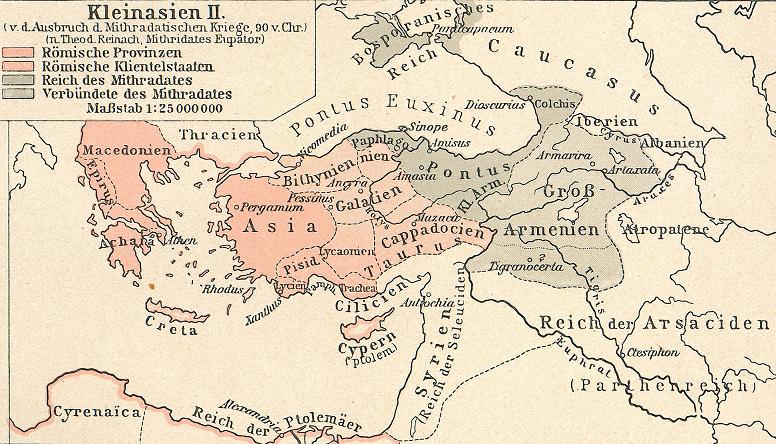 |
|
| Asia minor 90 BC (Image Wikipedia) | |
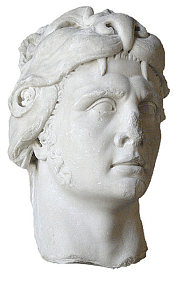     |
|
| Left: King Mithridates VI. of Pontus - Middle: Pompey the Great - Right: Lucius Cornelius Sulla Felix (image source: Wikipedia) | |
| He was called Pompeius Magnus and defeated king Mithridates VI. within two phases: first he renewed succesful the position on the sea with overcoming the pirate allies of king Mithridates VI. during their prowl for slaves, just when they sailed out of small rocky bays in western Cilicia and in the third and last mithridatic war (74 - 63 BC), where the kingdom of Pontos was conclusive conquered. In 63 BC Mithridates VI. fled to the castle of Pantikapaion on Crimea for suicide with poison, but only the second try with a sword of a slave ended his life. After he drubbed king Mithridates VI. he murdered and plundered Pontos, Syria, Palestine and Jerusalem and integrated them all in the roman empire. With this success Rome extended his direct sovereignty in the east. This brought enormous wealth to roman field commanders. | |
 |
|
| Asia minor 63 BC (Image Wikipedia) | |
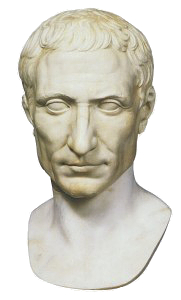 |
|
| Julius Cäsar (image source: Wikipedia) | |
| When Pompeius came back to Rome in 61 BC, he celebrated the biggest triumphal procession, Rome ever saw. So huge that all the plunder had to be carried with over 700 ships into the harbor and it needed two days to finish the whole spectacle. Onto banners with names of all the conquered countries, roman troops followed, royal prisoners, the booty of plundered cities, exotic animals, gold and silver statues of killed enemies, including the dead body of king Mithridates VI. of Pontos. Inside this century, the roman generals claimed blatantly more and more for an autonomous status, together for their own troops, but now a dictatorial sovereignty of a triumvirate took power over the empire (60-59 BC). One of those triumvir was Julius Caesar. The destination of the sunken ship of Antikythera was perhaps Rome, probably for a thriumpal celebration with booty of plunder. That this ship came from north east and the storm let the ship sunk at the eastern coast of Antikythera was a logical conclusion about the finding place of the shipwreck in the east of the island. | |
 |
|
| Marcus Tullius Cicero | |
| The national archaeologic museum of greece in Athens represents another these: around 70 BC, the roman politician, lawyer, writer, philosophe and consul Marcus Tullius Cicero frequently corresponded with his long year friend and compatriot Titus Pomponius Atticus (Quintus Caecilius Pomponianus), who settled in Athens. The intellectual and banker Atticus was a great benefactor for Athens, helped the city to rebuild just after the first mithridatic war and donated their citizens food. He purchased for his friend marble and bronze sculptures and its transport on his behalf from Piraeus to Italy via sea. With these works of arts Cicero would embellish some of his eight villas in Rome. In that time of conquests many rich and influential of the elite decorated with greek culture. | |
 |
|
|
With spedial thanks to: Jo Marchant Alexandros Sotiriou John Fardoulis |
|
 |
|
|
Sources: The Antikythera Mechanism Research Project National Archaeological Museum of Athens, Greece Eleni Kladaki-Vratsanou National Archive of Greece Harold Eugene Edgerton, USA Jacques Cousteau Foundation, France Vasilis Mendiogiannis Peter Nicolaides Lefteris Tsavliris Alexandros Sotiriou Dr. Brendan Foley, Deep Submergence Laboratory, Woods Hole Oceanographic Institution (WHOI), Woods Hole, MA 02543, USA Ephorate of Underwater Antiquities, D. Aeropagitou & Erechteiou 59, GR 117 42 Athens, Griechenland EdgeTech, USA ekathimerini.com, Kathimerini English Edition (International New York Times in Greece and Cyprus) Tony Freeth, Images First Ltd. Google Earth Nektaria Roumelioti J. F. White Contracting Co., Massachusetts, USA Nuytco Research, Canada "Mittelmeerkulturen in der Antike" by Michael Grant, published by C.H.Beck Verlag Munich, ISBN 3 406 05355 6 "Decoding the Heavens" by Jo Marchant, published by Rowohlt Verlag, ISBN 978 3 498 04517 3 "Antikythera Mechanism", Blogspot.de "The Antikythera computing device, the most complex instrument of antiquity", Hellenica ISAW Papers 4 (february, 2012), The Cosmos in the Antikythera Mechanism by Tony Freeth & Alexander Jones Bilder des Antikythera Mechanismus Forschungsprojekt, Konferenz in Athen Greek Reporter, "International Mission Exploring Antikythera Shipwreck", Nicoleta Kalmouki "The Antikythera Mechanism", Max Planck Institute for the History of Science, Boltzmannstr. 22 in 14195 Berlin, Germany "Fragmentary Knowledge. Was the Antikythera Mechanism the world’s first computer?" John Seabrook Mai 14, 2007, The New Yorker Youtube Anthony Ayiomamitis "Greek Archaeoastronomy - Antikythera Mechanism" NewScientist "Wearable Submarine to hunt for 2000-year-old computer", 04.06.2014 by Mark Harris Divernet "The Titanic of its time", March 2013 USA Today "Famed roman shipwreck reveals more secrets", 04.01.2013 by Dan Vergano Archaeology & Art "Underwater archaeological survey of Western Crete - Antikythera 2013", 23.12.2013 Projekt Contour School of Physics and Astronomy, "The Antikythera Shipwreck: the ship, the Treasures, the Mechanism", Prof Mike Edmunds, Cardiff University, 5, The Parade, Cardiff, CF24 3YB, Wales, UK Wikipedia |
|
|
|
|
|
Alle Markennamen sind eingetragene Warenzeichen und Eigentum der jeweiligen Hersteller - Sounddateien mit freundlicher Genehmigung durch Martin Filzwieser (www.zeiteisen.at) - IMPRESSUM |
|